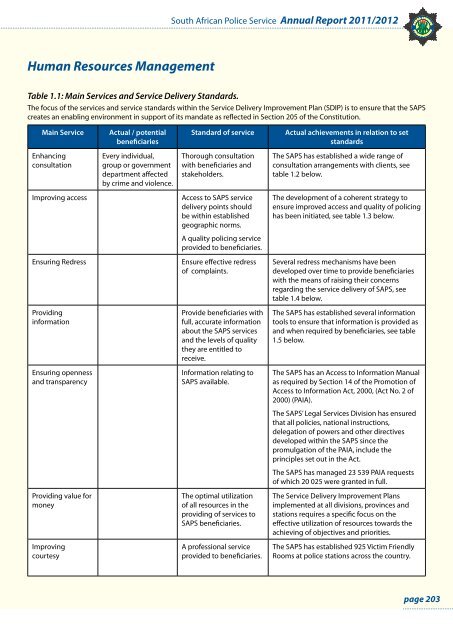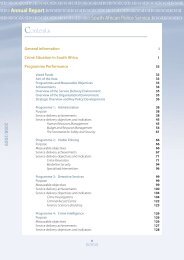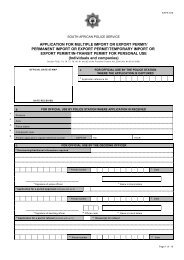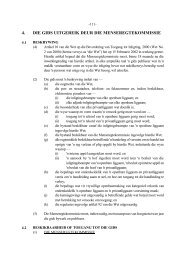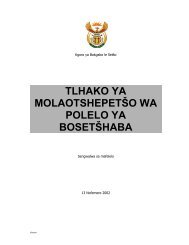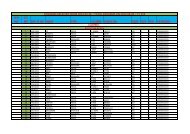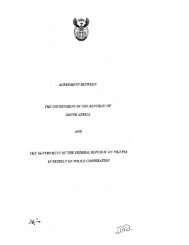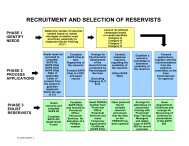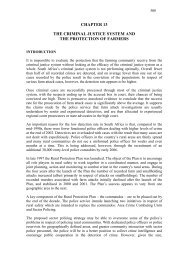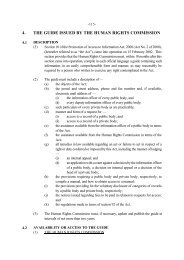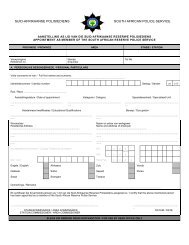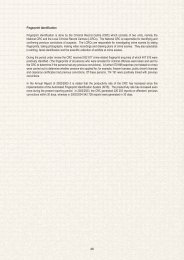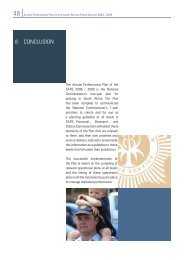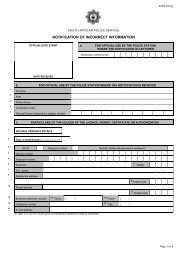Human Resources Management - Saps
Human Resources Management - Saps
Human Resources Management - Saps
You also want an ePaper? Increase the reach of your titles
YUMPU automatically turns print PDFs into web optimized ePapers that Google loves.
South African Police Service Annual Report 2011/2012<br />
<strong>Human</strong> <strong>Resources</strong> <strong>Management</strong><br />
www.saps.gov.za<br />
Table 1.1: Main Services and Service Delivery Standards.<br />
The focus of the services and service standards within the Service Delivery Improvement Plan (SDIP) is to ensure that the SAPS<br />
creates an enabling environment in support of its mandate as reflected in Section 205 of the Constitution.<br />
Main Service<br />
Actual / potential<br />
beneficiaries<br />
Standard of service<br />
Actual achievements in relation to set<br />
standards<br />
Enhancing<br />
consultation<br />
Every individual,<br />
group or government<br />
department affected<br />
by crime and violence.<br />
Thorough consultation<br />
with beneficiaries and<br />
stakeholders.<br />
The SAPS has established a wide range of<br />
consultation arrangements with clients, see<br />
table 1.2 below.<br />
Improving access<br />
Access to SAPS service<br />
delivery points should<br />
be within established<br />
geographic norms.<br />
A quality policing service<br />
provided to beneficiaries.<br />
The development of a coherent strategy to<br />
ensure improved access and quality of policing<br />
has been initiated, see table 1.3 below.<br />
Ensuring Redress<br />
Ensure effective redress<br />
of complaints.<br />
Several redress mechanisms have been<br />
developed over time to provide beneficiaries<br />
with the means of raising their concerns<br />
regarding the service delivery of SAPS, see<br />
table 1.4 below.<br />
Providing<br />
information<br />
Provide beneficiaries with<br />
full, accurate information<br />
about the SAPS services<br />
and the levels of quality<br />
they are entitled to<br />
receive.<br />
The SAPS has established several information<br />
tools to ensure that information is provided as<br />
and when required by beneficiaries, see table<br />
1.5 below.<br />
Ensuring openness<br />
and transparency<br />
Information relating to<br />
SAPS available.<br />
The SAPS has an Access to Information Manual<br />
as required by Section 14 of the Promotion of<br />
Access to Information Act, 2000, (Act No. 2 of<br />
2000) (PAIA).<br />
The SAPS’ Legal Services Division has ensured<br />
that all policies, national instructions,<br />
delegation of powers and other directives<br />
developed within the SAPS since the<br />
promulgation of the PAIA, include the<br />
principles set out in the Act.<br />
The SAPS has managed 23 539 PAIA requests<br />
of which 20 025 were granted in full.<br />
Providing value for<br />
money<br />
The optimal utilization<br />
of all resources in the<br />
providing of services to<br />
SAPS beneficiaries.<br />
The Service Delivery Improvement Plans<br />
implemented at all divisions, provinces and<br />
stations requires a specific focus on the<br />
effective utilization of resources towards the<br />
achieving of objectives and priorities.<br />
Improving<br />
courtesy<br />
A professional service<br />
provided to beneficiaries.<br />
The SAPS has established 925 Victim Friendly<br />
Rooms at police stations across the country.<br />
page 203
Table 1.2: Consultation arrangements with clients<br />
The aim of consultation arrangements is to ensure thorough consultation with beneficiaries and stakeholders.<br />
Type of<br />
arrangement<br />
Clients<br />
Actual achievements<br />
Awareness<br />
campaigns<br />
The general<br />
public, including<br />
children, youth and<br />
vulnerable groups.<br />
Various awareness campaigns were conducted in communities, giving<br />
attention to the specific needs regarding crimes prevalent in their area such as<br />
gender-based violence, the reduction of violent crimes, drug awareness, and<br />
promotion of community involvement in crime prevention.<br />
Rural Safety Rural community. The comprehensive Rural Safety Strategy to enhance safety and security,<br />
accessibility to policing and service delivery to the rural community was rolled<br />
out to all rural areas during 2011.<br />
A pilot project to assess the operational concept of the strategy was<br />
implemented at Harrismith in the Free State and Tsolo in the Eastern Cape<br />
where a high tendency of incidents of crime that affect rural communities,<br />
such as stock theft occur.<br />
Crime Prevention The general public. The SAPS has engaged in community-based partnerships to prevent crime and<br />
mobilise communities and specific sectors to address crimes that affect them.<br />
During 2011/12 the SAPS:<br />
• Received 88 985 calls and 845 web tips at its Crime Stop call centre which<br />
led to 432 positive cases and 658 arrests.<br />
• Received 2562 SMS tips and 1063 web tips as a result of the partnership<br />
between the Primedia Group and the SAPS which led to 109 positive cases<br />
and 182 arrests.<br />
Community Police<br />
Forums<br />
SAPS Strategic<br />
Plan 2010 to<br />
2014 (revised)<br />
and Annual<br />
Performance Plan<br />
2012/13<br />
The general public.<br />
Key stakeholders.<br />
Community Police Forums provide the general public with a forum that can be<br />
used to engage with the SAPS on its service delivery as well as specific crime<br />
tendencies and problems.<br />
The revised Strategic Plan 2010 to 2014 and the Annual Performance Plan<br />
2013/14 were consulted with a range of key stakeholders, including labour<br />
unions, business interests and JCPS Cluster Departments.<br />
Table 1.3: Service Delivery Access Strategies<br />
Service Delivery access addresses access to SAPS service delivery points within established geographic norms and the providing<br />
of a quality policing service to beneficiaries.<br />
Strategy<br />
Increase access to communities<br />
by building/upgrading/improving<br />
police stations.<br />
Access<br />
The Accessibility Study to inform the Access Strategy, which will inform the<br />
geographic norms and the ideal location of service delivery points, for the SAPS has<br />
been completed.<br />
A total of six police facilities were built during 2011/12 thereby improving the SAPS’<br />
ability to provide a service to citizens.<br />
Community Service Centers at 1 125 police stations throughout the country can be<br />
accessed physically or telephonically to access services provided by the SAPS.<br />
page 204
South African Police Service Annual Report 2011/2012<br />
www.saps.gov.za<br />
Strategy<br />
Service Delivery Charters.<br />
Access<br />
To ensure commitment of improved service delivery, Service Delivery Charters (SDC),<br />
a statement of service beneficiaries’ rights, services, service standards, complaints<br />
mechanisms and a service commitment statement, are available at all police stations.<br />
The SDC informs the service beneficiaries of the levels of service delivery they can<br />
expect at the point of service delivery. It also provides information on the costs<br />
involved for certain services, processes as well as contact information.<br />
Table 1.4: Complaints mechanism<br />
The purpose of the SAPS complaints mechanism is to ensure effective redress of complaints.<br />
Complaints mechanism<br />
Telephone and postal system<br />
(telephone number and<br />
addresses of service points and<br />
commanders)<br />
SAPS Website Complaints<br />
Mechanism<br />
Independent Police Investigative<br />
Directorate (IPID)<br />
SAPS National Complaints Line<br />
0860 13 08 06<br />
Presidential Hot Line (PHL)<br />
17737<br />
Anti-Corruption Hotline<br />
0800 701 701<br />
The SAPS can be contacted telephonically, letters of complaints can be sent to<br />
Station, Cluster or Unit Commanders. Contact numbers for all divisions, provincial<br />
offices, units, police stations and other contact points are available through the<br />
existing telephone and postal system.<br />
A link is available on the SAPS Website where the public can electronically complain<br />
about SAPS service delivery, corruption and fraud.<br />
The IPID operates independently from the SAPS and its mandate is to ensure that<br />
independent investigations of gross misconduct and criminality by SAPS members<br />
are conducted.<br />
The National Complaints Line of the SAPS is managed by the National Inspectorate.<br />
Complaints regarding poor service delivery can be made telephonically, which are<br />
then investigated by the SAPS.<br />
Members of the public can lodge their queries and complaints regarding service<br />
delivery with the PHL. These complaints are directed to the SAPS, which investigates<br />
the complaint and provides feedback.<br />
The Anti-Corruption Hotline is managed by the Public Service Commission. This<br />
toll free number can be used to report corruption in all Government Departments<br />
anonymously. Complaints relating to the corruption and fraud by SAPS members are<br />
forwarded to the SAPS for investigation.<br />
Table 1.5: Service Information Tool<br />
The service information tool must provide beneficiaries with full, accurate information about the SAPS services and the levels<br />
of quality they are entitled to receive.<br />
Types of Information<br />
Tools<br />
Information products and<br />
promotional items<br />
Television and radio<br />
broadcasts including<br />
adverts on print and<br />
electronic media and<br />
outdoor and digital<br />
advertising<br />
Information provided<br />
Booklets, leaflets, posters and promotional items were developed and distributed during<br />
projects, Izimbizo and awareness campaigns.<br />
“When Duty Calls”, a weekly programme on national television, informs the public regarding<br />
successes by the SAPS, crime prevention hints and requests for assistance in the fight against<br />
crime.<br />
Radio and television adverts on mainstream media were also run to communicate messages<br />
aimed at creating a safe and secure South Africa. Print media adverts also complemented the<br />
run on electronic media.<br />
Billboard advertising: festive season campaign.<br />
Digital advertising: festive season campaign and for supplier information sessions by Division<br />
Supply Chain <strong>Management</strong>.<br />
page 205
Types of Information<br />
Tools<br />
SAPS Internet and social<br />
media<br />
National, provincial and<br />
station exhibitions<br />
Service Delivery Charters<br />
and Service Delivery<br />
Improvement Plans<br />
SAPS Strategic Plan 2010<br />
to 2014 (revised)<br />
Annual Performance Plan<br />
2012/13<br />
Media liaison<br />
Internal Communication<br />
Information provided<br />
The SAPS website provides information on crime and crime prevention in South Africa. Social<br />
media (Twitter) is a platform used to interact with the general public on policing issues.<br />
Exhibitions were held at various community events to communicate key messages to the<br />
community relating to the combating of crime.<br />
Service Delivery Charters are visible at all police stations indicating the services and the<br />
standard of services provided.<br />
Service Delivery Improvement Plans are compiled at all levels to direct the improving of<br />
standards of service delivery.<br />
The SAPS Strategic Plan, which directs strategic and operational planning within the<br />
Department for a five-year period was revised to ensure its relevance to the changing<br />
environment.<br />
The plan was distributed to stakeholders and is available on the SAPS Website.<br />
The Annual Performance Plan 2012/13, extrapolated from the Strategic Plan, provides a<br />
clear indication of the strategic priorities within the context of the prevailing financial year,<br />
the measurable objectives and targets associated with the priorities, and guidelines for the<br />
implementation of the one-year focus.<br />
The plan was distributed to stakeholders and is available on the SAPS Website.<br />
Radio talk shows and interviews, live or recorded television interviews, media invites/<br />
statements, direct engagements with media houses are utilised to advise, educate and inform<br />
both local and international communities on SAPS successes, initiatives, safety hints and<br />
operations on policing matters.<br />
SAPS Journal on Line with Breaking News articles for use by the internal and external media.<br />
Various internal communication mediums exist such as:<br />
The SAPS Intranet (e.g. SAPS Strategic Plan, SAPS Annual Performance Plan, SAPS Annual<br />
Report, press releases and speeches, careers organisational information and vacant posts).<br />
PolTV (an in-house broadcast medium which serves as a platform for police management to<br />
communicate with its employees and to provide members with information regarding the<br />
SAPS priorities).<br />
The SAPS Journal (an in-house magazine which focuses on police successes and good<br />
practices).<br />
SAPS Twitter Page to submit comment important SAPS issues.<br />
SAPS SMS service to all official cell phones – important messages to SAPS employees.<br />
Monthly salary advices (reflects important messages from top management).<br />
Breaking News Advisory messages via the all email group to react to positive and negative<br />
media reports.<br />
Office of NATCOM messages on all email user group to make important announcements.<br />
Organisational Communication messages via the all email user group to inform SAPS<br />
employees on organisational matters.<br />
Police Bands – The Police Bands perform at events, imbizo’s, etc. They are excellent crowd<br />
pullers and also serve as SAPS Ambassadors for information discrimination.<br />
Corporate Identity – To enhance accessibility to Police Institutions through current branding in<br />
terms of the New Legislation.<br />
page 206
South African Police Service Annual Report 2011/2012<br />
www.saps.gov.za<br />
page 207
2. Expenditure<br />
The following tables summarize final audited expenditure by programme (Table 2.1) and by salary bands<br />
(Table 2.2). In particular, it provides an indication of the amount spent on personnel costs in terms of each<br />
of the programmes or salary bands within the department.<br />
TABLE 2.1 - Personnel costs by programme, 1 April 2011 to 31 March 2012<br />
Programme<br />
Total<br />
Expenditure<br />
(R'000)<br />
Compensation<br />
of Employees<br />
(R'000)<br />
Training<br />
Expenditure<br />
(R'000)<br />
Compensation<br />
of Employees as<br />
percent of Total<br />
Expenditure<br />
Average<br />
Compensation<br />
of Employees<br />
Cost per<br />
Employee<br />
(R'000)<br />
Employment<br />
Administration 19 263 922 10 966 150 1 170 146 18,9 305 35 929<br />
Visible Policing 24 761 973 20 225 129 34,9 185 109 053<br />
Detective Service 10 167 669 7 996 169 13,8 205 38 970<br />
Crime Intelligence 2 204 989 1 928 737 3,3 213 9 053<br />
Protection & Security<br />
Services<br />
1 534 568 1 311 517 2,3 207 6 340<br />
TOTAL 57 933 121 42 427 702 1 170 146 73,2 213 199 345<br />
TABLE 2.2 - Personnel costs by salary bands, 1 April 2011 to 31 March 2012<br />
Salary Bands<br />
Compensation of<br />
Employees Cost<br />
(R'000)<br />
Percentage of Total<br />
Compensation of<br />
Employees<br />
Average<br />
Compensation of<br />
Employees per<br />
Employee (R'000)<br />
Number of<br />
Employees<br />
Lower skilled (Levels 1-2) 703 084 1,7 70 9 981<br />
Skilled (Levels 3-5) 15 560 839 36,7 155 100 351<br />
Highly skilled production (Levels 6-8) 18 418 370 43,4 230 79 988<br />
Highly skilled supervision (Levels 9-12) 7 109 946 16,8 861 8 254<br />
Senior management (Levels 13-16)<br />
and Executive Authority<br />
635 463 1,5 824 771<br />
TOTAL 42 427 702 100 213 199 345<br />
page 208
South African Police Service Annual Report 2011/2012<br />
The following tables provide a summary per programme (Table 2.3) and salary bands (Table 2.4), of expenditure incurred as a result of salaries,<br />
overtime, homeowners allowance and medical assistance. In each case, the table provides an indication of the percentage of the personnel<br />
budget that was used for these items.<br />
TABLE 2.3 - Salaries, overtime, home owners allowance and medical assistance by programme, 1 April 2011 to 31 March 2012<br />
Total<br />
Compensation<br />
of Employees<br />
per Programme<br />
(R'000)<br />
Medical<br />
Assistance<br />
as % of<br />
Compensation<br />
of Employees<br />
Medical<br />
Assistance<br />
(R'000)<br />
Home Owners<br />
Allowance<br />
as % of<br />
Compensation<br />
of Employees<br />
Home Owners<br />
Allowance<br />
(R'000)<br />
Overtime<br />
as % of<br />
Compensation<br />
of Employees<br />
Overtime<br />
(R'000)<br />
Programme Salaries (R'000) Salaries as % of<br />
Compensation<br />
of Employees<br />
Administration 4 862 575 44,3 20 293 0,2 283 677 2,6 634 253 5,8 10 966 150<br />
Visible Policing 14 435 327 71,4 272 901 1,3 861 659 4,3 2 830 125 14 20 225 129<br />
Detective Service 5 857 852 73,3 61 901 0,8 318 052 4 965 699 12,1 7 996 169<br />
Crime Intelligence 1 426 524 74 10 855 0,6 72 424 3,8 216 511 11,2 1 928 737<br />
Protection & Security Services 880 304 67,1 101 690 7,8 53 378 4,1 161 140 12,3 1 311 517<br />
TOTAL 27 462 582 64,7 467 640 1,1 1 589 190 3,7 4 807 728 11,3 42 427 702<br />
TABLE 2.4 - Salaries, overtime, home owners allowance and medical assistance by salary band, 1 April 2011 to 31 March 2012<br />
Total<br />
Compensation<br />
of Employees<br />
per Salary<br />
Band (R'000)<br />
Medical<br />
Assistance<br />
as % of<br />
Compensation<br />
of Employees<br />
Medical<br />
Assistance<br />
(R'000)<br />
Home Owners<br />
Allowance<br />
as % of<br />
Compensation<br />
of Employees<br />
Home Owners<br />
Allowance<br />
(R'000)<br />
Overtime<br />
as % of<br />
Compensation<br />
of Employees<br />
Overtime<br />
(R'000)<br />
Salaries<br />
as % of<br />
Compensation<br />
of Employees<br />
Salary bands Salaries<br />
(R'000)<br />
Lower skilled (Levels 1-2) 467 028 1,1 1 649 0,0 55 086 0,1 296 502 0,7 703 084<br />
Skilled (Levels 3-5) 9 697 663 22,9 189 300 0,4 855 458 2,0 3 705 360 8,7 15 560 839<br />
12 055 919 28,4 225 001 0,5 551 369 1,3 800 913 1,9 18 418 370<br />
Highly skilled production<br />
(Levels 6-8)<br />
4 777 967 11,3 51 690 0,1 125 253 0,3 3 374 0,0 7 109 946<br />
Highly skilled supervision<br />
(Levels 9-12)<br />
464 005 1,1 0 0,0 2 024 0,0 1 579 0,0 635 463<br />
Senior management (Levels<br />
13-16) and Executive Authority<br />
TOTAL 27 462 582 64,7 467 640 1,1 1 589 190 3,7 4 807 728 11,3 42 427 702<br />
www.saps.gov.za<br />
page 209
3. Employment and Vacancies<br />
The following tables summarize the year-end establishment, the number of employees, the vacancy rate,<br />
and whether there are any staff that are additional to the establishment. This information is presented<br />
in terms of three key variables: - programme (Table 3.1), salary band (Table 3.2) and critical occupations<br />
(Table 3.3).<br />
TABLE 3.1 - Employment and vacancies by programme at end of period, 1 April 2011 to 31 March 2012<br />
Programme<br />
Year-end<br />
establishment<br />
Number of<br />
Employees<br />
Vacancy Rate (%)<br />
*Number of Staff<br />
Additional to the<br />
Establishment<br />
Administration 34 820 35 929 -3,2 0<br />
Visible Policing 106 606 109 053 -2,3 0<br />
Detective Service 40 212 38 970 3,1 0<br />
Crime Intelligence 10 777 9 053 16 0<br />
Protection & Security<br />
5 515 6 340 -15 0<br />
Services<br />
TOTAL 197 930 199 345 -0,7 0<br />
TABLE 3.2 - Employment and vacancies by salary band at end of period, 1 April 2011 to 31 March 2012<br />
Salary Bands<br />
Year-end<br />
establishment<br />
Number of<br />
Employees<br />
Vacancy Rate (%)<br />
*Number of Staff<br />
Additional to the<br />
Establishment<br />
Lower skilled (Levels 1-2) 9 770 9 981 -2,2 0<br />
Skilled (Levels 3-5) 98 233 100 351 -2,2 0<br />
Highly skilled production<br />
(Levels 6-8)<br />
78 871 79 988 -1,4 0<br />
Highly skilled supervision<br />
(Levels 9-12)<br />
10 142 8 254 18,6 0<br />
Senior management (Levels<br />
13-16)<br />
912 769 15,7 0<br />
Minister and Deputy<br />
Minister<br />
2 2 0,0 0<br />
TOTAL 197 930 199 345 -0,7 0<br />
*Note: As at 31 March 2012, a total of 59 SMS positions have been advertised and in process of consideration or review. The structures for<br />
Forensic Services, Crime Intelligence, Protection and Security Services, Strategic <strong>Management</strong> as well as station structures are under review.<br />
Some posts towards the senior management level have been earmarked for the structural review but are still under a Job Evaluation process.<br />
page 210
South African Police Service Annual Report 2011/2012<br />
www.saps.gov.za<br />
TABLE 3.3 - Employment and vacancies by critical occupations, 1 April 2011 to 31 March 2012<br />
Critical Occupations<br />
Year-end<br />
establishment<br />
Number of<br />
Employees<br />
Vacancy Rate (%)<br />
*Number of Staff<br />
Additional to the<br />
Establishment<br />
Aircraft pilots & related<br />
associate professionals<br />
47 46 2,1 0<br />
Architects town and traffic<br />
planners<br />
3 3 0 0<br />
Chemists 1 174 1 173 0,1 0<br />
Engineers and related<br />
professionals<br />
130 130 0 0<br />
General legal administration<br />
& related professionals<br />
418 418 0 0<br />
Natural sciences related 6 6 0 0<br />
Police 146 018 145 229 0,5 0<br />
Psychologists and vocational<br />
counsellors<br />
97 96 1 0<br />
TOTAL 147 893 147 101 0,5 0<br />
*Note: The Head of Department/Chief Executive Officer and Senior Managers are, by their very nature, critical occupations, but have not been<br />
separately listed. Hence critical occupations have been addressed within the Occupational Classes of Aircraft Pilots; Architects; Chemists<br />
(Physical Science,Chemical Science, Pharmacists & Health Science Related); Engineer & related professionals (Electronic & Engineering science);<br />
General Legal Administration & Related Professionals (Attorneys, Legal Administration & Legal related); Natural science; Police (Functional<br />
Personnel SAPS) and Psychologists & vocational science. The critical occupations (Occupational Classes) do not reflect all the positions filled<br />
within SAPS, but only those, which are considered as a priority for the optimal functioning of SAPS’s core functions.<br />
page 211
4. Filling of Posts<br />
TABLE 4.1 - SMS establishment information as on 31 March 2012<br />
SMS Band<br />
Year-end<br />
establishment<br />
Total Number of<br />
SMS members<br />
per Band<br />
% of SMS<br />
positions filled<br />
per Bands<br />
Total Number of<br />
SMS positions<br />
vacant per Band<br />
% of SMS<br />
positions vacant<br />
per Bands<br />
Band A 705 570 81 135 19,1<br />
Band B 175 167 95 8 4,6<br />
Band C 31 31 100 0 0,0<br />
Band D 1 1 100 0 0,0<br />
TOTAL 914 769 85 143 15,7<br />
TABLE 4.2 - SMS establishment information as on 30 September 2011<br />
SMS Band<br />
Year-end<br />
establishment<br />
Total Number of<br />
SMS members<br />
per Band<br />
% of SMS<br />
positions filled<br />
per Bands<br />
Total Number of<br />
SMS positions<br />
vacant per Band<br />
% of SMS<br />
positions vacant<br />
per Bands<br />
Band A 689 545 79 144 20,9<br />
Band B 175 135 77 40 22,9<br />
Band C 31 28 90 3 9,7<br />
Band D 1 1 100 0 0,0<br />
TOTAL 896 709 79 187 20,9<br />
*Note: The mid-year esrtablishment as on 30 September 2011 was in accordance with the Department’s HR Plan and excluded positions ring<br />
fenced for expansions and other organisational demands.<br />
TABLE 4.3 - Advertising and filling of SMS positions as on 31 March 2012<br />
SMS Band Advertising Filling of positions<br />
Number of Vacancies per<br />
Band advertised in 6 months<br />
of becoming vacant<br />
Number of Vacancies per<br />
Band filled in 6 months after<br />
becoming vacant<br />
Number of Vacancies not<br />
filled in 6 months but filled in<br />
12 months<br />
Band A 166 108 10<br />
Band B 69 52 2<br />
Band C 4 4 0<br />
Band D 0 0 0<br />
TOTAL 239 164 12<br />
TABLE 4.4 - Reasons for not having complied with the filling of vacant SMS positions - Advertised within 6<br />
months and filled within 12 months after becoming vacant<br />
Reasons for vacancies not advertised within 6 months<br />
In compliance - Please refer to note<br />
page 212
South African Police Service Annual Report 2011/2012<br />
www.saps.gov.za<br />
Reasons for vacancies not filled within 12 months<br />
A post was evaluated and advertised on SMS Band A. Structural adjustments affecting the specific post were subsequently<br />
considered and a job evaluation processes was conducted. The envisaged structural adjustments were however not<br />
supported by the job evaluation results. Due to the aforementioned process and the time that has lapsed, the post has been<br />
earmarked for re-advertisement.<br />
TABLE 4.5 - Disciplinary steps taken for not complying with the prescribed timeframes for filling SMS<br />
positions within 12 months<br />
Not applicable<br />
Note: Positions are funded over a multi-year period according to predetermined targets of the total establishment, taking into account<br />
personnel losses. Vacant positions at a certain level or in terms of a specific business unit are therefor planned and regarded as funded only<br />
upon the date of advertisement. With reference to table 4.3, a total of 59 positions have been advertised and in process of consideration or<br />
review.<br />
page 213
5. Job Evaluation<br />
The Public Service Regulations, 1999 introduced job evaluation as a way of ensuring that work of equal<br />
value is remunerated equally. With regard to the SAPS, the Equate Job Evaluation System is utilized to<br />
determine the salary levels for positions on National and Provincial levels whereas the Resource Allocation<br />
Guide (RAG) is utilized to determine salary levels for station positions. Table 5.1 indicates the number of<br />
positions evaluated by utilizing the two systems.<br />
TABLE 5.1 - Job evaluation, 1 April 2011 to 31 March 2012<br />
Salary Bands<br />
Number of<br />
Employees<br />
Number<br />
of Jobs<br />
Evaluated<br />
% of Jobs<br />
Evaluated by<br />
Salary Bands<br />
Number of<br />
positions<br />
Upgraded<br />
% of<br />
Upgraded<br />
positions<br />
Evaluated<br />
Number of<br />
positions<br />
Downgraded<br />
% of<br />
Downgraded<br />
positions<br />
Evaluated<br />
Lower skilled<br />
(Levels 1-2)<br />
9 981 0 0 0 0 0 0<br />
Skilled (Levels<br />
3-5)<br />
100 351 1 0 0 0 0 0<br />
Highly skilled<br />
production<br />
79 988 39 0 0 0 0 0<br />
(Levels 6-8)<br />
Highly skilled<br />
supervision<br />
8 254 747 9,1 0 0 0 0<br />
(Levels 9-12)<br />
Senior<br />
management<br />
771 282 36,6 0 0 0 0<br />
(Levels 13-16)<br />
TOTAL 199 345 1 069 0,5 0 0 0 0<br />
TABLE 5.2 - Profile of employees whose positions were upgraded due to their jobs being upgraded, 1 April<br />
2011 to 31 March 2012<br />
None<br />
TABLE 5.3 - Employees whose salary level exceed the grade determined by job evaluation, 1 April 2011 to<br />
31 March 2012 [i.t.o PSR 1.V.C.3]<br />
None<br />
TABLE 5.4 - Profile of employees whose salary level exceeded the grade determined by job evaluation,<br />
1 April 2011 to 31 March 2012 [i.t.o. PSR 1.V.C.3]<br />
None<br />
With regard to tables 5.2 to 5.4 vacant newly created positions are evaluated and then filled through the<br />
normal advertisement and filling procedure, therefore no individual employees were affected by job<br />
evaluations in terms of their salary levels.<br />
page 214
South African Police Service Annual Report 2011/2012<br />
6. Employment Changes<br />
This section provides information on changes in employment over the financial year. Turnover rates<br />
provide an indication of trends in the employment profile of the department. The following tables provide<br />
a summary of turnover rates by salary bands (Table 6.1) and by critical occupations (Table 6.2).<br />
www.saps.gov.za<br />
TABLE 6.1 - Annual turnover rates by salary bands, 1 April 2011 to 31 March 2012<br />
Salary Bands<br />
*Employment at Recruitments Terminations Turnover Rate (%)<br />
Beginning of Period<br />
(April 2011)<br />
Lower skilled (Levels 1-2) 2 517 7 544 80 3,2<br />
Skilled (Levels 3-5) 99 994 1 348 991 1<br />
Highly skilled production<br />
(Levels 6-8)<br />
80 857 622 1 491 1,8<br />
Highly skilled supervision<br />
(Levels 9-12)<br />
8 392 26 164 2<br />
Senior management<br />
(Levels 13-16)<br />
794 10 33 4,2<br />
TOTAL 192 554 9 550 2 759 1,4<br />
*Note: Employment at the end of the previous period, as reported in the Department’s Annual Report for 2010/2011, will differ from<br />
employment at the beginning of this period due to service terminations and appointments recorded in 2011/2012 with a salary effective<br />
date prior to 31 March 2011. Significant movements between salary levels are effected as a result of in-year promotions and salary level<br />
progressions (Recruits).<br />
TABLE 6.2 - Annual turnover rates by critical occupation, 1 April 2011 to 31 March 2012<br />
Critical Occupations *Employment at Recruitments Terminations Turnover Rate (%)<br />
Beginning of Period<br />
(April 2011)<br />
Aircraft pilots & related<br />
associate professionals<br />
48 3 5 10,4<br />
Architects town and<br />
traffic planners<br />
6 0 3 50<br />
Chemists 1 021 160 8 0,8<br />
Engineers and related<br />
professionals<br />
124 8 2 1,6<br />
General legal<br />
administration & related<br />
221 204 7 3,2<br />
professionals<br />
Natural sciences related 6 0 0 0<br />
Police 142 205 4 897 1 873 1,3<br />
Psychologists and<br />
vocational counsellors<br />
90 11 5 5,6<br />
TOTAL 143 721 5 283 1 903 1,3<br />
*Note: Employment at the end of the previous period, as reported in the Department’s Annual Report for 2010/2011, will differ from<br />
employment at the beginning of this period due to service terminations and appointments recorded in 2011/2012 with a salary effective<br />
date prior to 31 March 2011. Significant movements between salary levels are effected as a result of in-year promotions and salary level<br />
progressions (Recruits).<br />
page 215
TABLE 6.3 - Reasons why staff are leaving the department, 1 April 2011 to 31 March 2012<br />
Termination Types Number % of Total<br />
Resignations<br />
% of Total<br />
Employment<br />
Total<br />
Total<br />
Employment<br />
Death 862 31,2 0,4 2 759 199 345<br />
Resignation 1 013 36,7 0,5 2 759 199 345<br />
Expiry of contract 28 1 0 2 759 199 345<br />
Discharged due to ill<br />
212 7,7 0,1 2 759 199 345<br />
health<br />
Dismissal-misconduct 116 4,2 0,1 2 759 199 345<br />
Retirement 504 18,3 0,3 2 759 199 345<br />
Other 24 0,9 0 2 759 199 345<br />
TOTAL 2 759 100 1,4 2 759 199 345<br />
TABLE 6.4 - Section 35 terminations, 1 April 2011 to 31 March 2012<br />
RANK<br />
Number of Section 35 terminations awarded<br />
Major General 1<br />
*Note: The amount paid by SAPS to the employee on 2011.10.07 amounted to R1 097 503.91. The payment was in respect of leave gratuity,<br />
pro-rata service bonus, severance package and notice period. The additional liability towards the Government Pension Administration Agency<br />
(GPAA) as on 2012.03.31 amounts to R2 392 764.80.<br />
TABLE 6.5 - Promotions by critical occupation, 1 April 2011 to 31 March 2012<br />
Critical Occupations Employment at the End of<br />
Period<br />
Promotions to another<br />
Salary Level<br />
Aircraft pilots & related associate<br />
professionals<br />
Salary Level Promotions<br />
as a % of Employment<br />
46 0 0<br />
Architects town and traffic planners 3 0 0<br />
Chemists 1 173 0 0<br />
Engineers and related professionals 130 2 1,5<br />
General legal administration &<br />
related professionals<br />
418 0 0<br />
Natural sciences related 6 0 0<br />
Police 145 229 9 161 6,3<br />
Psychologists and vocational<br />
counsellors<br />
96 1 1<br />
TOTAL 147 101 9 164 6,2<br />
page 216
South African Police Service Annual Report 2011/2012<br />
TABLE 6.6 - Promotions by salary band, 1 April 2011 to 31 March 2012<br />
Salary Bands<br />
Employment at the End of<br />
Period<br />
Promotions to another<br />
Salary Level<br />
www.saps.gov.za<br />
Salary Level Promotions as<br />
a % of Employment<br />
Lower skilled (Levels 1-2) 9 981 146 1,5<br />
Skilled (Levels 3-5) 100 351 25 0<br />
Highly skilled production<br />
(Levels 6-8)<br />
79 988 8 992 11,2<br />
Highly skilled supervision<br />
(Levels 9-12)<br />
8 254 537 6,5<br />
Senior management<br />
(Levels 13-16)<br />
771 159 20,6<br />
TOTAL 199 345 9 859 4,9<br />
TABLE 6.7 - Regulation 45 appointments, 1 April 2011 to 31 March 2012<br />
The following number of members were promoted by the National Commissioner in terms of the provisions<br />
of the South African Police Service Employment Regulations, 2008, which provides for the promotion of<br />
members without following the advertisement and selection process, due to the specific merits of the<br />
cases<br />
RANK<br />
Number of<br />
Promotions<br />
in terms of<br />
Regulation 45<br />
Major General 1<br />
Brigadier 4<br />
Colonel 8<br />
Lieutenant Colonel 3<br />
Captain 1<br />
Lieutenant 2<br />
Warrant Officer 3<br />
Sergeant 4<br />
TOTAL 26<br />
page 217
7. Employment Equity<br />
The tables in this section are based on the formats prescribed by the Employment Equity Act, 55 of 1998.<br />
TABLE 7.1 - Total number of employees (incl. employees with disabilities) in each of the following occupational category<br />
as on 31 March 2012<br />
Occupational Categories Male,<br />
African<br />
Legislators, senior officials<br />
and managers<br />
Male,<br />
Coloured<br />
Male,<br />
Indian<br />
Male,<br />
Total<br />
Blacks<br />
Male,<br />
White<br />
Female,<br />
African<br />
Female,<br />
Coloured<br />
Female,<br />
Indian<br />
Female,<br />
Total<br />
Blacks<br />
Female,<br />
White<br />
308 57 36 401 129 158 19 10 187 54 771<br />
Professionals 3 128 436 277 3 841 1 565 2 292 384 227 2 903 1 697 10 006<br />
Clerks 6 735 928 311 7 974 576 15 746 3 063 799 19 608 4 809 32 967<br />
Service and sales workers 86 005 11 714 3 048 100 767 11 458 27 152 3 475 508 31 135 2 971 146 331<br />
Craft and related trades<br />
workers<br />
Plant and machine operators<br />
and assemblers<br />
538 113 43 694 306 33 0 0 33 7 1 040<br />
196 9 5 210 8 12 0 0 12 0 230<br />
Elementary occupations 3 576 561 20 4 157 43 3 295 469 9 3 773 27 8 000<br />
TOTAL 100 486 13 818 3 740 118 044 14 085 48 688 7 410 1 553 57 651 9 565 199 345<br />
Total<br />
Male,<br />
African<br />
Male,<br />
Coloured<br />
Male,<br />
Indian<br />
Male,<br />
Total<br />
Blacks<br />
Male,<br />
White<br />
Female,<br />
African<br />
Female,<br />
Coloured<br />
Employees with disabilities 509 107 29 645 392 177 40 10 227 206 1 470<br />
Female,<br />
Indian<br />
Female,<br />
Total<br />
Blacks<br />
Female,<br />
White<br />
Total<br />
page 218
South African Police Service Annual Report 2011/2012<br />
www.saps.gov.za<br />
TABLE 7.2 - Total number of employees in each of the following occupational bands as on 31 March 2012<br />
Occupational Bands Male,<br />
African<br />
Male,<br />
Coloured<br />
Male,<br />
Indian<br />
Male,<br />
Total<br />
Blacks<br />
Male,<br />
White<br />
Female,<br />
African<br />
Female,<br />
Coloured<br />
Top management 17 3 1 21 2 8 0 0 8 3 34<br />
Senior management 291 54 35 380 127 150 19 10 179 51 737<br />
Professionally qualified and<br />
experienced<br />
Skilled technical and<br />
academically qualified<br />
Semi-skilled and<br />
discretionary decision<br />
making<br />
Unskilled and defined<br />
decision making<br />
Female,<br />
Indian<br />
Female,<br />
Total<br />
Blacks<br />
Female,<br />
White<br />
3 249 484 365 4 098 1 623 1 462 230 121 1 813 720 8 254<br />
42 009 6 202 2 412 50 623 11 157 8 775 1 874 823 11 472 6 736 79 988<br />
50 503 6 618 822 57 943 1 090 33 913 4 827 576 39 316 2 002 100 351<br />
4 417 457 105 4 979 86 4 380 460 23 4 863 53 9 981<br />
TOTAL 100 486 13 818 3 740 118 044 14 085 48 688 7 410 1 553 57 651 9 565 199 345<br />
Total<br />
TABLE 7.3 - Recruitment for the period 1 April 2011 to 31 March 2012<br />
Occupational Bands Male,<br />
African<br />
Male,<br />
Coloured<br />
Male,<br />
Indian<br />
Male,<br />
Total<br />
Blacks<br />
Male,<br />
White<br />
Female,<br />
African<br />
Female,<br />
Coloured<br />
Top management 0 0 0 0 0 0 0 0 0 0 0<br />
Senior management 0 0 0 0 0 0 0 0 0 0 0<br />
Professionally qualified and<br />
experienced<br />
Skilled technical and<br />
academically qualified<br />
Semi-skilled and<br />
discretionary decision<br />
making<br />
Unskilled and defined<br />
decision making<br />
Female,<br />
Indian<br />
Female,<br />
Total<br />
Blacks<br />
Female,<br />
White<br />
11 0 1 12 4 10 0 0 10 0 26<br />
235 47 7 289 58 196 20 18 234 41 622<br />
456 37 14 507 25 670 84 22 776 40 1 348<br />
3 372 282 87 3 741 43 3 431 304 15 3 750 10 7 544<br />
TOTAL 4 074 366 109 4 549 130 4 307 408 55 4 770 91 9 540<br />
Total<br />
page 219
TABLE 7.4 - Progression to another salary notch for the period 1 April 2011 to 31 March 2012<br />
Occupational Bands Male,<br />
African<br />
Male,<br />
Coloured<br />
Male,<br />
Indian<br />
Male,<br />
Total<br />
Blacks<br />
Male,<br />
White<br />
Female,<br />
African<br />
Female,<br />
Coloured<br />
Top management 8 1 1 10 2 4 0 0 4 0 16<br />
Senior management 251 53 37 341 130 134 12 7 153 46 670<br />
Professionally qualified and<br />
experienced<br />
Skilled technical and<br />
academically qualified<br />
Semi-skilled and<br />
discretionary decision<br />
making<br />
Unskilled and defined<br />
decision making<br />
Female,<br />
Indian<br />
Female,<br />
Total<br />
Blacks<br />
Female,<br />
White<br />
2 658 342 134 3 134 410 1 382 202 76 1 660 321 5 525<br />
11 097 2 043 331 13 471 984 5 506 1 313 435 7 254 3 431 25 140<br />
19 227 2 677 447 22 351 561 19 160 3 119 449 22 728 1 633 47 273<br />
771 127 8 906 22 714 93 5 812 25 1 765<br />
TOTAL 34 012 5 243 958 40 213 2 109 26 900 4 739 972 32 611 5 456 80 389<br />
Total<br />
TABLE 7.5 - Terminations for the period 1 April 2011 to 31 March 2012<br />
Occupational Bands Male,<br />
African<br />
Male,<br />
Coloured<br />
Male,<br />
Indian<br />
Male,<br />
Total<br />
Blacks<br />
Male,<br />
White<br />
Female,<br />
African<br />
Female,<br />
Coloured<br />
Top management 4 0 1 5 0 0 0 0 0 0 5<br />
Senior management 10 1 0 11 15 0 0 0 0 2 28<br />
Professionally qualified and<br />
experienced<br />
Skilled technical and<br />
academically qualified<br />
Semi-skilled and<br />
discretionary decision<br />
making<br />
Unskilled and defined<br />
decision making<br />
Female,<br />
Indian<br />
Female,<br />
Total<br />
Blacks<br />
Female,<br />
White<br />
69 5 5 79 47 11 3 0 14 24 164<br />
804 109 48 961 249 80 8 11 99 182 1 491<br />
513 79 16 608 21 266 49 4 319 43 991<br />
39 11 0 50 4 21 3 1 25 1 80<br />
TOTAL 1 439 205 70 1 714 336 378 63 16 457 252 2 759<br />
Total<br />
page 220
South African Police Service Annual Report 2011/2012<br />
www.saps.gov.za<br />
TABLE 7.6 - Disciplinary actions for the period 1 April 2011 to 31 March 2012<br />
Disciplinary Actions Male,<br />
African<br />
Male,<br />
Coloured<br />
Male,<br />
Indian<br />
Male,<br />
Total<br />
Blacks<br />
Male,<br />
White<br />
Female,<br />
African<br />
Female,<br />
Coloured<br />
Correctional counseling 80 29 7 116 12 1 2 0 3 0 131<br />
Demotion 0 0 0 0 0 0 0 0 0 0 0<br />
Dismissal 343 80 5 428 29 19 7 0 26 7 490<br />
Final written warning 188 84 9 281 22 8 1 0 9 3 315<br />
Fine 607 127 24 758 45 24 5 0 29 5 837<br />
Suspended dismissal 487 143 15 645 49 32 7 0 39 6 739<br />
Case withdrawn 429 206 15 650 69 33 15 0 48 10 777<br />
Not quilty 699 228 35 962 84 45 7 2 54 9 1 109<br />
Suspended without payment 18 5 2 25 1 0 0 0 0 0 26<br />
Verbal warning 40 22 1 63 9 3 2 0 5 0 77<br />
Written warning 265 99 18 382 40 16 3 0 19 9 450<br />
Postponement of sanction 95 12 0 107 13 6 1 0 7 0 127<br />
TOTAL 3 251 1 035 131 4 417 373 187 50 2 239 49 5 078<br />
Female,<br />
Indian<br />
Female,<br />
Total<br />
Blacks<br />
Female,<br />
White<br />
Total<br />
TABLE 7.7 - Skills development for the period 1 April 2011 to 31 March 2012<br />
Occupational Bands Male,<br />
African<br />
Male,<br />
Coloured<br />
Male,<br />
Indian<br />
Male,<br />
Total<br />
Blacks<br />
Male,<br />
White<br />
Female,<br />
African<br />
Female,<br />
Coloured<br />
Top management 3 0 0 3 0 1 0 0 1 2 6<br />
Senior management 234 41 34 309 133 141 25 10 176 47 665<br />
Professionally qualified and<br />
experienced<br />
Skilled technical and<br />
academically qualified<br />
Semi-skilled and<br />
discretionary decision<br />
making<br />
Unskilled and defined<br />
decision making<br />
Female,<br />
Indian<br />
Female,<br />
Total<br />
Blacks<br />
Female,<br />
White<br />
3 898 695 454 5 047 1 594 1 765 290 159 2 214 722 9 577<br />
37 279 8 276 3 083 48 638 11 913 8 036 1 974 719 10 729 4 366 75 646<br />
43 012 8 088 720 51 820 1 081 23 876 3 810 327 28 013 939 81 853<br />
4 446 1 704 84 6 234 529 5 001 1 276 14 6 291 99 13 153<br />
TOTAL 88 872 18 804 4 375 112 051 15 250 38 820 7 375 1 229 47 424 6 175 180 900<br />
Total<br />
*Note: Total number of members declared competent in all training interventions completed during the period 1 April 2011 to 31 March 2012 as per the Training Administration System on<br />
15 June 2012.<br />
page 221
8. Performance Rewards<br />
TABLE 8.1 - Signing of performance agreements by SMS members as on 31 May 2011<br />
SMS Band<br />
Total Number of<br />
Funded SMS Posts<br />
Total Number of SMS<br />
members per Band<br />
Total Number of<br />
Signed Performance<br />
Agreements<br />
Signed Performance<br />
Agreements as a<br />
Percentage of Total<br />
Number of SMS<br />
Members<br />
Band A 705 570 138 0<br />
Band B 175 167 22 13<br />
Band C 31 31 2 7<br />
Band D 1 1 0 0<br />
TOTAL 914 769 162 21<br />
•Note: The signing of performance agreements is captured on the SAPS PERSAP system. The information above reflects the total number of<br />
senior managers that, according to the system, signed their performance agreement by 31 May 2011. Information of senior managers that<br />
were not required to conclude a performance agreement (i.e. external deployment, newly appointed, etc), were excluded from the above.<br />
TABLE 8.2 - Reasons for not having concluded performance agreements for all SMS members.<br />
The SAPS Employment Regulations allow for signing of performance agreements by the end of July of each year. This is<br />
due to the fact that information from some systems only becomes available by the end of May whereafter senior managers<br />
are required to customise their performance agreements in terms of the available information. The verification of some<br />
information is for example only completed by the end of May of each year by the Auditor General. By the end of July 2011<br />
(in accordance with SAPS Employment Regulations), 88% of the senior managers had signed performance agreements.<br />
Some senior managers had compiled and signed a performance agreement in time, but the delay in registering the<br />
performance agreement was due to the supervisor not signing the performance agreement timeously. The highest<br />
compliance rate achieved for signing of performance agreements during 2011/2012 was 96,3%. The figure does however<br />
fluctuate through the year due to new appointments, resignations, etc.<br />
TABLE 8.3 - Disciplinary steps taken against SMS members for not having concluded performance<br />
agreements.<br />
No disciplinary steps have been taken to date. A process has been initiated to exclude non-complying senior managers<br />
from receiving of pay progression on 2012/04/01.<br />
To encourage good performance, the department has granted the following performance reward during<br />
the year under review.<br />
page 222
South African Police Service Annual Report 2011/2012<br />
TABLE 8.4 - Performance rewards by race and gender, 1 April 2011 to 31 March 2012<br />
Demographics<br />
*Number of<br />
Beneficiaries<br />
Total<br />
Employment<br />
% of Total within<br />
Group<br />
Cost (R'000)<br />
Average Cost per<br />
Beneficiary (R)<br />
African, Female 9 48 688 0,0 147 16 333<br />
African, Male 8 100 486 0,0 145 18 125<br />
Asian, Female 0 1 553 0,0 0 0<br />
Asian, Male 1 3 740 0,0 62 62 000<br />
Coloured, Female 0 7 410 0,0 0 0<br />
Coloured, Male 0 13 818 0,0 0 0<br />
Total Blacks, Female 9 57 651 0,0 147 16 333<br />
Total Blacks, Male 9 118 044 0,0 207 23 000<br />
White, Female 1 9 565 0,0 17 17 000<br />
White, Male 2 14 085 0,0 34 17 000<br />
TOTAL 21 199 345 0,0 405 19 286<br />
*Note: Performance Rewards paid in the 2011/2012 financial year were for services rendered in the 2010/2011 financial year.<br />
www.saps.gov.za<br />
TABLE 8.5 - Performance rewards by salary bands for personnel below senior management, 1 April 2011 to<br />
31 March 2012<br />
Salary Bands<br />
*Number of<br />
Beneficiaries<br />
Total<br />
Employment<br />
% of Total<br />
per Level and<br />
Employment<br />
Cost (R'000)<br />
Average Cost per<br />
Beneficiary (R)<br />
Lower skilled<br />
(Levels 1-2)<br />
0 9 981 0 0 0<br />
Skilled (Levels 3-5) 4 100 351 0 23 5 750<br />
Highly skilled<br />
production<br />
5 79 988 0 53 10 600<br />
(Levels 6-8)<br />
Highly skilled<br />
supervision<br />
7 8 254 0,1 136 19 429<br />
(Levels 9-12)<br />
TOTAL 16 198 574 0 212 13 250<br />
*Note: Performance Rewards paid in the 2011/2012 financial year were for services rendered in the 2010/2011 financial year. The classification<br />
of beneficiaries were done in accordance with the salary band profile of employees as at 31 March 2012.<br />
page 223
TABLE 8.6 - Performance Rewards by Critical Occupation, 1 April 2011 to 31 March 2012<br />
Critical Occupations<br />
Number of<br />
Beneficiaries<br />
Total<br />
Employment<br />
% of Total<br />
Employment<br />
Cost (R'000)<br />
Average Cost per<br />
Beneficiary (R)<br />
Aircraft pilots & related<br />
associate professionals<br />
0 46 0 0 0<br />
Architects town and<br />
traffic planners<br />
0 3 0 0 0<br />
Chemists 0 1 173 0 0 0<br />
Engineers and related<br />
professionals<br />
0 130 0 0 0<br />
General legal<br />
administration & related<br />
0 418 0 0 0<br />
professionals<br />
Natural sciences related 0 6 0 0 0<br />
Police 0 145 229 0 0 0<br />
Psychologists and<br />
vocational counsellors<br />
0 96 0 0 0<br />
TOTAL 0 147 101 0 0 0<br />
TABLE 8.7 - Performance rewards by salary bands for senior management, 1 April 2011 to 31 March 2012<br />
SMS Band<br />
*Number of<br />
Beneficiaries<br />
Total<br />
Employment<br />
% of Total<br />
per Band and<br />
Employment<br />
Cost (R'000)<br />
Average Cost per<br />
Beneficiary (R)<br />
Band A 4 570 0,7 170 42 500<br />
Band B 1 167 0,6 21 21 000<br />
Band C 0 31 0 0 0<br />
Band D 0 1 0 0 0<br />
Minister and Deputy<br />
Minister<br />
0 2 0 0 0<br />
TOTAL 5 771 0,6 191 38 200<br />
*Note: Performance Rewards paid in the 2011/2012 financial year were for services rendered in the 2010/2011 financial year.<br />
9. Foreign Workers<br />
The Department did not employ any foreign workers for the period 1 April 2011 to 31 March 2012.<br />
page 224
South African Police Service Annual Report 2011/2012<br />
10. Leave<br />
The Public Service Commission identified the need for careful monitoring of sick leave within the public<br />
service. The following tables provide an indication of the use of sick leave (Table 9.1) and disability leave<br />
(Table 9.2). In both cases, the estimated cost of the leave is also provided.<br />
www.saps.gov.za<br />
TABLE 10.1 - Sick leave for 1 January 2011 to 31 December 2011<br />
Salary Bands Total Days % Days with<br />
Medical<br />
Certification<br />
Number of<br />
Employees<br />
using Sick<br />
Leave<br />
% of Total<br />
Employees<br />
using Sick<br />
Leave<br />
Average<br />
Days per<br />
Employee<br />
Estimated<br />
Cost (R'000)<br />
Total<br />
number of<br />
Employees<br />
using Sick<br />
Leave<br />
Total<br />
number of<br />
days with<br />
medical<br />
certification<br />
Lower skilled<br />
(Levels 1-2)<br />
20 416 92,4 2 629 1,9 8 4 549 141 736 18 867<br />
Skilled (Levels<br />
3-5)<br />
621 970 93,6 74 069 52,3 8 225 857 141 736 581 906<br />
Highly skilled<br />
production 469 536 94 52 494 37 9 298 020 141 736 441 160<br />
(Levels 6-8)<br />
Highly skilled<br />
supervision<br />
99 850 93,9 12 135 8,6 8 101 161 141 736 93 755<br />
(Levels 9-12)<br />
Senior<br />
management 3 013 94,6 409 0,3 7 8 681 141 736 2 851<br />
(Levels 13-16)<br />
TOTAL 1 214 785 93,7 141 736 100 9 638 268 141 736 1 138 539<br />
TABLE 10.2 - Incapacity leave (temporary and permanent) for 1 January 2011 to 31 December 2011<br />
Salary Bands Total Days % Days with<br />
Medical<br />
Certification<br />
Number of<br />
Employees<br />
using<br />
Incapacity<br />
Leave<br />
% of Total<br />
Employees<br />
using<br />
Incapacity<br />
Leave<br />
Average<br />
Days per<br />
Employee<br />
Estimated<br />
Cost (R'000)<br />
Total<br />
number of<br />
days with<br />
medical<br />
certification<br />
Total<br />
number of<br />
Employees<br />
using<br />
Incapacity<br />
Leave<br />
Lower skilled<br />
(Levels 1-2)<br />
4 088 100 137 2,4 30 925 4 088 5 822<br />
Skilled<br />
(Levels 3-5)<br />
61 101 100 1 890 32,5 32 21 000 61 100 5 822<br />
Highly skilled<br />
production 138 758 99,4 3 063 52,6 45 90 433 137 986 5 822<br />
(Levels 6-8)<br />
Highly skilled<br />
supervision<br />
29 376 99,9 714 12,3 41 29 957 29 358 5 822<br />
(Levels 9-12)<br />
Senior<br />
management<br />
998 100 18 0,3 55 3 001 998 5 822<br />
(Levels 13-16)<br />
TOTAL 234 321 99,7 5 822 100 40 145 316 233 530 5 822<br />
page 225
TABLE 10.3 - Temporary incapacity leave for 1 January 2011 to 31 December 2011<br />
Type of incapacity leave<br />
considered<br />
Health Risk Manager Number of disputes How were disputes<br />
resolved<br />
Acceptance of advice Deviation from advice<br />
Short term incapacity 334 0 0 Not applicable<br />
Long term incapacity 97 0 0 Not applicable<br />
Types of illness<br />
For the reporting period the highest number of applications for short term temporary incapacity leave were for respiratory<br />
conditions followed by muscular skeletal and mental and behavioral conditions. For long periods of temporary incapacity<br />
leave, psychiatric conditions were the leading cause.<br />
TABLE 10.4 - Ill-health retirement for 1 January 2011 to 31 December 2011<br />
Incapacity leave<br />
approved<br />
Health Risk Manager Number of disputes How were disputes<br />
resolved<br />
Acceptance of advice Deviation from advice<br />
Number of cases referred 255 51 0 N/A<br />
Types of illness<br />
Psychological and medical conditions were the leading cause for ill-health retirement applications.<br />
TABLE 10.5 - Expenditure incurred for Temporary and Ill-health retirements (Health Risk Manager) for the<br />
period 1 January 2011 to 31 December 2011<br />
Total expenditure incurred (R'000)<br />
Average timeframe for payments made to service provider<br />
R36,263 12 days<br />
TABLE 10.6 - Annual Leave for 1 January 2011 to 31 December 2011<br />
Salary Bands Total Days Taken Average days per<br />
Employee<br />
Number of Employees<br />
who took leave<br />
Lower skilled (Levels 1-2) 52 254 16 3 350<br />
Skilled (Levels 3-5) 1 731 408 20 85 771<br />
Highly skilled production (Levels 6-8) 1 721 385 25 69 607<br />
Highly skilled supervision (Levels 9-12) 458 287 25 18 069<br />
Senior management (Levels 13-16) 17 446 23 760<br />
TOTAL 3 980 780 22 177 557<br />
TABLE 10.7 - Capped Leave for 1 January 2011 to 31 December 2011<br />
Salary Bands<br />
Total days of<br />
capped leave<br />
taken<br />
Average number<br />
of days taken per<br />
employee<br />
Number of<br />
Employees who<br />
took Capped<br />
leave<br />
Total number<br />
of capped leave<br />
(June 2000)<br />
available at 31<br />
December 2011<br />
Lower skilled (Levels 1-2) 40 20 2 1 454<br />
Skilled (Levels 3-5) 2 457 6 402 210 153<br />
Highly skilled production (Levels 6-8) 32 006 8 3 854 4 018 285<br />
Highly skilled supervision (Levels 9-12) 9 408 8 1 175 1 576 136<br />
Senior management (Levels 13-16) 140 5 30 72 355<br />
TOTAL 44 051 8 5 463 5 878 383<br />
page 226
South African Police Service Annual Report 2011/2012<br />
11. HIV/AIDS and Health Promotion Programmes<br />
www.saps.gov.za<br />
TABLE 11.1 - Steps taken to reduce the risk of occupational exposure<br />
Categories of employees identified<br />
to be at high risk of contracting HIV /<br />
AIDS and related diseases<br />
Detectives<br />
Functional police members<br />
Forensic scientists<br />
Fingerprint experts<br />
Key steps taken to reduce the risk<br />
Detective surgical gloves are issued to all functional members, detectives, forensic<br />
scientists and fingerprint experts.<br />
During safety, health and environment training, the need for gloves and safe<br />
working procedures are explained to members in accordance with the regulations<br />
for Hazardous Biological Agents.<br />
All members have access to post-exposure prophylactic drugs that are paid for by<br />
the SAPS as employer.<br />
All occupational accidents involving body fluids and blood contamination are<br />
reported and being dealt with by the Section: SHE <strong>Management</strong>, Head Office.<br />
TABLE 11.2 - Details of Health Promotion and HIV/AIDS Programmes Programmes<br />
Question Yes No Details, if Yes<br />
1. Has the department designated a<br />
member of the SMS to implement<br />
the provisions contained in Part<br />
VI E of Chapter 1 of the Public<br />
Service Regulations, 2001? If<br />
so, provide her/his name and<br />
position.<br />
x<br />
Divisional Commissioner NNM Mazibuko<br />
Head: Personnel <strong>Management</strong>, SAPS<br />
Private Bag X94<br />
Pretoria, 0001<br />
Tel no: 012 393 4472<br />
Fax no: 012 393 2454<br />
2. Does the department have<br />
a dedicated unit or have you<br />
designated specific staff members<br />
to promote health and well being<br />
of your employees? If so, indicate<br />
the number of employees who<br />
are involved in this task and the<br />
annual budget that is available for<br />
this purpose.<br />
3. Has the department introduced<br />
an Employee Assistance or Health<br />
Promotion Programme for your<br />
employees? If so, indicate the<br />
key elements/services of the<br />
programme.<br />
4. Has the department established<br />
(a) committee(s) as contemplated<br />
in Part VI E.5 (e) of Chapter 1 of<br />
the Public Service Regulations,<br />
2001? If so, please provide the<br />
names of the members of the<br />
committee and the stakeholder(s)<br />
that they represent.<br />
x<br />
x<br />
x<br />
The Employee Health & Wellness consists of four sections namely; Social<br />
Worker Services, Psychological Services, Spiritual Services and Quality<br />
of Work-Life comprising of professionals who are mainly responsible<br />
for the psycho-socio and spiritual well-being of all SAPS employees as<br />
well as their immediate family members. There is approximately 600<br />
professionals employed within the EHW environment rendering care<br />
and support services to SAPS employees nationally. The section Quality<br />
of Work-Life (QWL) comprise of HIV&AIDS and Disability <strong>Management</strong>,<br />
which is a budgeted Programme. To date, there has been an annual<br />
budget of R5 million and R4 million respectively for both programmes.<br />
The component Employee Health and Wellness delivers services<br />
of which the key elements are wellness support programmes such<br />
as stress and trauma management, suicide prevention, spiritually<br />
based programmes, life-skills, personal financial management,<br />
colleague sensitivity, HIV&AIDS awareness programmes and disability<br />
sensitization programmes. The wellness support programmes are<br />
currently being expanded to include health promotion programmes<br />
whereby employees are being tested for HIV and other chronic<br />
conditions such as high blood pressure, diabetes, cholesterol and body<br />
mass index on a voluntary basis.<br />
The Division Personnel <strong>Management</strong> within SAPS is the custodian of the<br />
National Wellness Strategic Forum which is a monitoring vehicle of all<br />
aspects related to the health and wellness of SAPS employees including<br />
their immediate family members. The forum consists of representatives<br />
from various Divisions within SAPS such as Divisional Commissioners of<br />
Personnel <strong>Management</strong> (chairperson), <strong>Human</strong> Resource Development,<br />
Legal Services, Supply Chain <strong>Management</strong>, <strong>Human</strong> Resource Utilization<br />
as well as and Organized Labour unions (POPCRU and SAPU). There are<br />
also key external role-players such as Department of Public Works,<br />
page 227
Question Yes No Details, if Yes<br />
4. Continued..... POLMED, QUALSA (administrator to POLMED), Metropolitan Health<br />
Group (managed health care provider to POLMED); GEMS and SAPS’s<br />
Health Risk Manager (PHS). Similar structures have been established<br />
in the Provinces. Both the national and provincial wellness fora are<br />
being convened on a quarterly basis and strategic reports are being<br />
shared amongst all the role-players regarding the health and wellness of<br />
employees.<br />
5. Has the department reviewed<br />
the employment policies and<br />
practices of your department to<br />
ensure that these do not unfairly<br />
discriminate against employees<br />
on the basis of their HIV status? If<br />
so, list the employment policies/<br />
practices so reviewed.<br />
x<br />
SAPS has recently revised the HIV&AIDS Workplace Policy to include<br />
other communicable diseases such as TB, cholera, malaria etc. The<br />
draft policy is currently being consulted with various role-players for<br />
comments and inputs. It further makes provision for information,<br />
education and communication, preventative measures, medical<br />
testing as well as care and support structures and services available for<br />
employees and their immediate family members. The draft policy also<br />
outlines principles of confidentiality counselling and testing of members<br />
as well as availability and accessibility of health and wellness services.<br />
Currently all interventions relating to HIV&AIDS management in the<br />
workplace are being implemented by professionals (social workers,<br />
psychologists, psychometrics, and chaplains) as mandated by the latter<br />
strategic plan.<br />
6. Has the department introduced<br />
measures to protect HIVpositive<br />
employees or those<br />
perceived to be HIV-positive from<br />
discrimination? If so, list the key<br />
elements of these measures.<br />
7. Does the department encourage<br />
its employees to undergo<br />
Voluntary Counselling and<br />
Testing? If so, list the results that<br />
you have achieved.<br />
x<br />
x<br />
The Policy on Employees of the SAPS living with HIV/AIDS was approved<br />
in August 2001. SAPS also abides by Acts such as the Employment<br />
Equity Act, the Basic Conditions of Employment Act as well as the<br />
Labour Relations Act, which prohibit discrimination against employees<br />
on the basis of their status.<br />
An increased number of SAPS employees partake ongoingly in the<br />
HIV Counselling and Testing (HCT) programme. Mobile Wellness on<br />
Wheels services are available in all Provinces. The Employee Health and<br />
Wellness as well as other service providers such as POLMED forged<br />
partnership in marketing the Health Weeks campaigns/ drive within<br />
SAPS. Furthermore, the Health Risk Manager also ensures that rigorous<br />
HIV Counselling and Testing sessions are being conducted on an<br />
ongoing basis with increased testing sites. Employees are encouraged to<br />
optimally utilize the testing services which have been made available for<br />
them in order to know their general health status, manage it accordingly<br />
and to register on the relevant Disease <strong>Management</strong> Programmes if and<br />
when necessary.<br />
Furthermore, SAPS also provides care and support to all employees in<br />
need by means of various Wellness Support Groups. The department is<br />
also embarking on an ongoing drive of providing advocacy workshops<br />
to senior managers through the Peer Education Programme with the<br />
purpose of setting positive examples and pledging care and support<br />
to those infected and affected by various health problems including<br />
HIV&AIDS.<br />
8. Has the department developed<br />
measures/indicators to monitor<br />
& evaluate the impact of your<br />
health promotion programme? If<br />
so, list these measures/indicators.<br />
x<br />
Organizational indicators, e.g. suicide rates and trends regarding<br />
referrals and medical boards, are constantly monitored.<br />
page 228
South African Police Service Annual Report 2011/2012<br />
12. Labour Relations<br />
www.saps.gov.za<br />
TABLE 12.1 - Collective agreements, 1 April 2011 to 31 March 2012<br />
Number Name of agreement Date signed<br />
Agreement 1/2011 Sexual Harassment in the workplace 18-Jan-11<br />
Agreement 2/2011<br />
SAPS Rank Structure, Revised Promotion<br />
05-Apr-11<br />
Policy and matters thereto<br />
Agreement 3/2011<br />
Promotion and Grade Progression in the<br />
SAPS<br />
28-Sep-11<br />
TABLE 12.2 - Misconduct and discipline hearings finalised, 1 April 2011 to 31 March 2012<br />
Outcome of Disciplinary Hearings Number % of Total<br />
Correctional counseling 136 2,5<br />
Demotion 0 0,0<br />
Dismissal 532 9,6<br />
Final written warning 337 6,1<br />
Fine 978 17,7<br />
Postponement of sanction 130 2,3<br />
Suspended dismissal 792 14,3<br />
Case withdrawn 864 15,6<br />
Not guilty 1 185 21,4<br />
Suspended without payment 27 0,5<br />
Verbal warning 80 1,4<br />
Written warning 479 8,6<br />
TOTAL 5 540 100<br />
page 229
TABLE 12.3 - Types of misconduct addressed and disciplinary hearings, 1 April 2011 to 31 March 2012<br />
Regulation 20 Nature Number<br />
Persons<br />
Found<br />
Guilty<br />
page 230<br />
% of Total<br />
(a) Fails to comply with, or contravenes an Act, regulation or legal obligation 425 14,7<br />
(b) Wilfully or negligently mismanages the finances of the State. 12 0,4<br />
(c) Without permission possesses or uses the property of the State, another<br />
89 3,1<br />
employee or a visitor.<br />
(d) Intentionally or negligently damages and or causes loss of State property. 110 3,8<br />
(e) Endangers the lives of others by disregarding safety rules or regulations. 20 0,7<br />
(f) Prejudices the administration, discipline or efficiency of a department, office or<br />
109 3,8<br />
institution of the State.<br />
(g) Misuses his or her position in the Service to promote or to prejudice the interest<br />
4 0,1<br />
of any political party.<br />
(h) Accepts any compensation in cash or otherwise from a member of the public<br />
1 0,0<br />
or another employee for performing her or his duties without written approval<br />
from the employer.<br />
(i) Fails to carry out a lawful order or routine instruction without just or reasonable<br />
276 9,5<br />
cause.<br />
(j) Absents himself or herself from work without reason or permission. 390 13,4<br />
(k) Commits an act of sexual harassment. 10 0,3<br />
(l) Unfairly discriminates against others on the basis of race, gender, disability,<br />
12 0,4<br />
sexuality or other grounds prohibited by the Constitution.<br />
(m) Without written approval of the employer performs work for compensation in<br />
3 0,1<br />
a private capacity for another person or organisation either during or outside<br />
working hours.<br />
(n) Without authorisation, sleeps on duty. 7 0,2<br />
(o) While on duty, is under the influence of an intoxicating, illegal, unauthorised,<br />
117 4,0<br />
habit-forming drugs, including alcohol.<br />
(p) While on duty, conducts herself or himself in an improper, disgraceful and<br />
98 3,4<br />
unacceptable manner.<br />
(q) Contravenes any prescribed Code of Conduct for the Service or the Public<br />
47 1,6<br />
Service, whichever may be applicable to him or her.<br />
(r) Incites other employees to unlawful conduct or conduct in conflict with<br />
0 0,0<br />
accepted procedure.<br />
(s) Displays disrespect towards others in the workplace or demonstrates abusive or<br />
49 1,7<br />
insolent behaviour.<br />
(t) Intimidates or victimises other employees. 2 0,1<br />
(u) Prevent other employees from belonging to any trade union. 0 0,0<br />
(v) Operates any money lending scheme for employees during working hours or<br />
0 0,0<br />
from the premises of Service.<br />
(w) Gives a false statement or evidence in the execution of his or her duties. 6 0,2<br />
(x) Falsifies records or any other documentation. 13 0,4<br />
(y) Participates in any unlawful labour or industrial action. 2 0,1<br />
(z) Commits a common law or statutory offence. 1 098 37,9<br />
TOTAL 2 900 100
South African Police Service Annual Report 2011/2012<br />
www.saps.gov.za<br />
TABLE 12.4 - Grievances lodged for the period 1 April 2011 to 31 March 2012<br />
Number of Grievances Addressed Number % of Total<br />
Not resolved 143 9,1<br />
Resolved 1 423 90,9<br />
TOTAL 1 566 100<br />
TABLE 12.5 - Disputes lodged with Councils for the period 1 April 2011 to 31 March 2012<br />
Number of Disputes Lodged Number % of total<br />
SSSBC 562 82,9<br />
PSCBC 50 7,4<br />
CCMA 43 6,3<br />
Private Arbitrations 23 3,4<br />
TOTAL 678 100<br />
TABLE 12.6 - Strike actions for the period 1 April 2011 to 31 March 2012<br />
Strike Actions<br />
Total<br />
Total number of person working days lost 0<br />
Total cost (R'000) of working days lost 0<br />
Amount (R'000) recovered as a result of no work no pay 0<br />
TABLE 12.7 - Precautionary suspensions for the period 1 April 2011 to 31 March 2012<br />
Precautionary Suspensions<br />
Totals / Amount<br />
Number of people suspended 916<br />
Number of people whose suspension exceeded 90 days 306<br />
Average number of days suspended 91,48<br />
Cost (R'000) of suspensions R18,581<br />
“Note: Precautionary suspensions are Regulation 13 suspensions and exclude the following suspensions:<br />
Section 43 - Imprisonments<br />
Regulation 18 (5) - Fail to appear at disciplinary hearing<br />
Regulation 16 (4) - Appeals”<br />
page 231
13. Skills Development<br />
This section highlights the efforts of the department with regard to skills development.<br />
TABLE 13.1 - Members attending training for the period 1 April 2011 to 31 March 2012<br />
Occupational Bands Gender Course<br />
Learning<br />
Programme Qualification Refresher<br />
Course<br />
Skills<br />
Programme<br />
Workshop<br />
Total<br />
Top management Female 3 0 0 0 0 0 3<br />
Male 3 0 0 0 0 0 3<br />
Senior management Female 213 0 2 0 0 26 241<br />
Male 416 0 0 0 0 41 457<br />
Professionally qualified<br />
and experienced<br />
Female 2 148 43 4 5 409 556 3 165<br />
Male 4 467 106 9 6 1 178 1 209 6 975<br />
Skilled technical and<br />
academically qualified<br />
Female 10 774 172 2 15 2 449 3 042 16 454<br />
Male 37 758 502 10 35 14 851 13 590 66 746<br />
Semi-skilled and<br />
discretionary decision Female 20 412 67 5 8 5947 5 987 32 426<br />
making<br />
Male 33 038 85 16 12 16 209 9 887 59 247<br />
Unskilled and defined<br />
decision making<br />
Female 6 073 0 0 0 105 1 153 7 331<br />
Male 6 552 0 0 0 192 865 7 609<br />
Gender sub totals Female 39 623 282 13 28 8 910 10 764 59 620<br />
Male 82 234 693 35 53 32 430 25 592 141 037<br />
Total 121 857 975 48 81 41 340 36 356 200 657<br />
*Note: Total number member attending training for the period 1 April 2011 to 31 March 2012 as per Training Administration System on<br />
15 June 2012.<br />
page 232
South African Police Service Annual Report 2011/2012<br />
www.saps.gov.za<br />
TABLE 13.2 - Members found competent in training provided for the period 1 April 2011 to 31 March<br />
2012<br />
Occupational Bands Gender Course Learning<br />
Programme<br />
14. Injury on Duty<br />
Qualification<br />
Refresher<br />
Course<br />
Skills<br />
Programme<br />
Workshop<br />
Top management Female 3 0 0 0 0 0 3<br />
Male 3 0 0 0 0 0 3<br />
Senior management Female 195 0 2 0 0 26 223<br />
Male 401 0 0 0 0 41 442<br />
Professionally qualified<br />
and experienced<br />
Female 2 047 42 4 5 282 556 2 936<br />
Male 4 331 103 9 6 983 1 209 6 641<br />
Skilled technical and<br />
academically qualified<br />
Female 10 230 170 2 15 1 650 3 028 15 095<br />
Male 35 184 499 10 35 11 415 13 408 60 551<br />
Semi-skilled and<br />
discretionary decision Female 19 790 66 5 8 3 099 5 984 28 952<br />
making<br />
Male 31 815 84 16 12 11 090 9 884 52 901<br />
Unskilled and defined<br />
decision making<br />
Female 5 180 0 0 0 57 1 153 6 390<br />
Male 5 767 0 0 0 131 865 6 763<br />
Gender sub totals Female 37 445 278 13 28 5 088 10 747 53 599<br />
Male 77 501 686 35 53 23 619 25 407 127 301<br />
Total 114 946 964 48 81 28 707 36 154 180 900<br />
*Note: Total number of members declared competent in all training interventions completed during the period 1 April 2011 to 31 March 2012<br />
as per the Training Administration System on 15 June 2012.<br />
Total<br />
The following table provides basic information on injury on duty.<br />
TABLE 14.1 - Injury on duty reported, 1 April 2011 to 31 March 2012<br />
Nature of injury on duty Number % of total<br />
Required medical attention with no temporary<br />
disablement<br />
649 7,3<br />
Required medical attention with temporary<br />
disablement<br />
7 537 85,3<br />
Permanent disablement 491 5,6<br />
Fatal 163 1,8<br />
Total 8 840<br />
page 233
15. Utilisation of Consultants<br />
See page 173 which refers to goods and services, of which “consultants, contractors and special services”<br />
is a sub-classification.<br />
page 234


